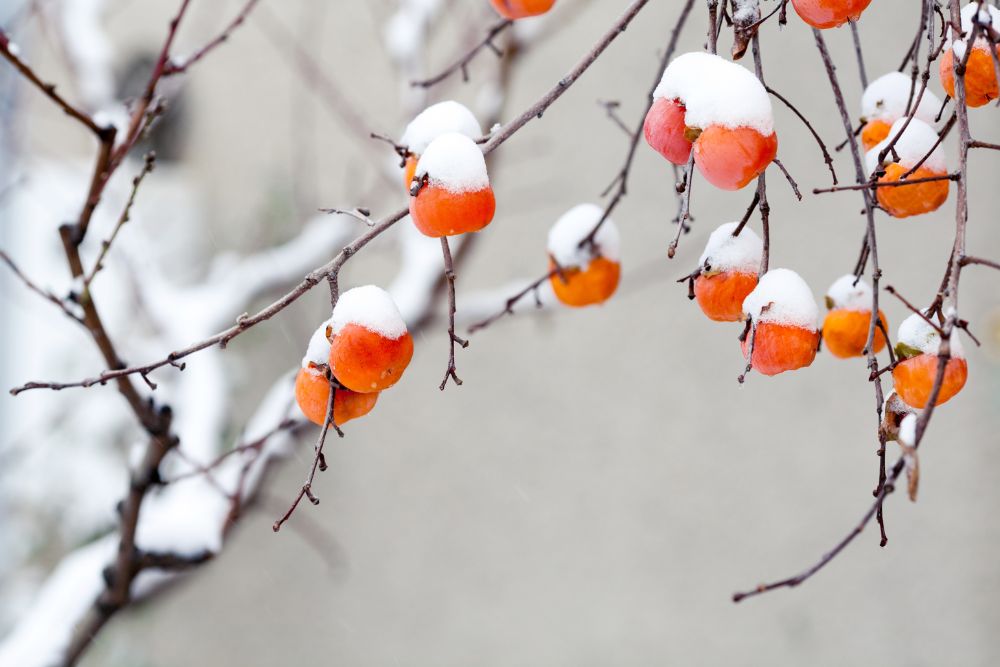Native Trees, Shrubs, Herbaceous Perennials – Shop Now, Farm Pickup
Native Trees, Shrubs, Herbaceous Perennials – Shop Now, Farm Pickup
|

The Latin name for Persimmon, Diospyros, literally means “divine fruit.” So it’s no surprise that it was a staple of Native American orchards for centuries. Yet many of us have never tasted this delicious native fruit! Why isn’t American Persimmon more common today? And what makes it so special?

Persimmons are widely available at the grocery store, but they’re almost always of the Asian (Diospyros kaki) variety. They’re tasty, but can’t hold a candle to a ripe American Persimmon (Diospyros virginiana), which are often thought to taste astringent because they’re eaten too early. When ripe, they taste deliciously sweet, with a soft pulp – comparable to a rich custard with caramel notes.

What makes them delicious – their soft sweet pulp – also makes them hard to transport for sale, at least as whole fruits. But this also makes them perfect to process into jam or custard-like pulp that can be used in pies, baby food, smoothies, and other tasty treats. Try Persimmon pie instead of pumpkin. Or use the sweet, rich pulp to make a delicious bourbon-persimmon-walnut bread.

Not only are they delicious; they’re also incredibly nutritious. No other temperate fruit compares to Persimmon in terms of nutritional value: it’s higher in Vitamin C than an orange and contains 19 of the 20 essential amino acids. Animals travel far and wide to consume this “fruit of the gods,” which ripens in the fall and provides fresh fruit when little else is available.

Livestock are lucky to live in agroforestry systems that include native fruits like Persimmon. The nutrient dense fruits ripen and drop from September through February, providing a slow feed through the winter months. Packed full of vitamins and amino acids, livestock can be nourished when no fresh forage is available. In the hot summer months, the trees provide shade, helping to reduce heat stress and increase animal health and wellbeing. Persimmon also host important pollinators and beneficial native insects.

Unlike other more common fruits, Diospyros virginiana can grow across ecological zones and habitats, from sandy soils to heavy clay to rocky hillsides. It’s relatively free of pests and diseases, low maintenance, and able to produce bountiful crops without the use of artificial fertilizers, pesticides, herbicides, and fungicides. When one considers the time, energy, and toxins put into a conventional peach orchard, there simply is no comparison.
One thing to keep in mind when planting American Persimmons is that they are dioecious, meaning trees have either male or female flowers (though occasionally trees will produce both types of flowers or flowers with both male and female parts). In order to produce fruit, you need to plant both male and female trees. Thankfully, grafted cultivar persimmon trees are female, taking away a layer of confusion when purchasing a tree at a nursery. For production orchards, it is recommended to plant one male tree for every 12 female trees. If space is limited, planting only female grafted cultivars will often produce fruit without male pollination, creating smaller seedless fruit.
Now more than ever, especially at a time of rapid climate change, we need hardy, resilient, and abundant trees like American Persimmon in landscapes across the country. Perhaps one day persimmon can become a staple again, and we’ll all hold this soft, decadent treasure in our hands with the utmost care.
Visit our Nursery Shop to learn more about how to grow American Persimmon and plant some on your farm or backyard.